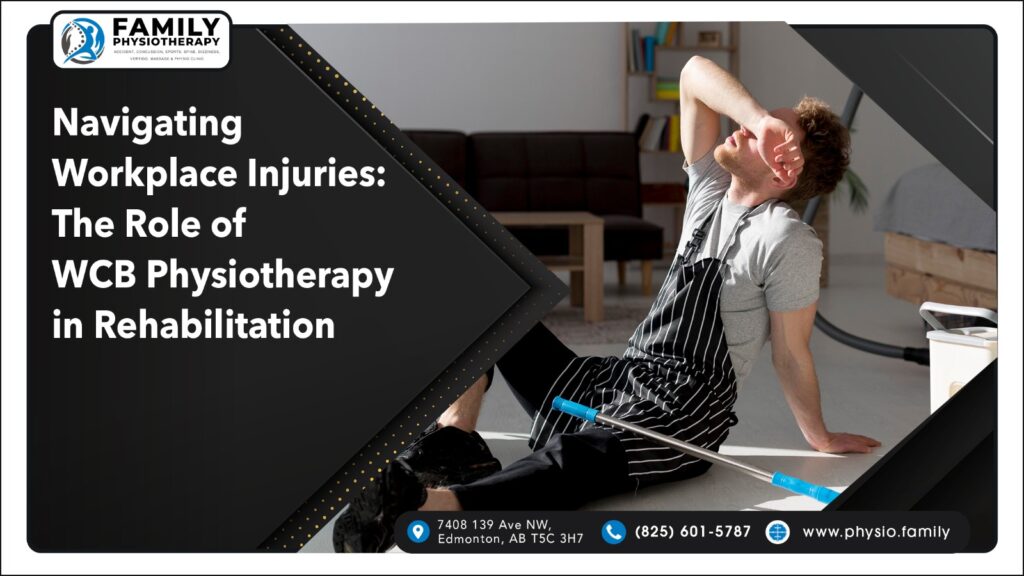
In occupational health, workplace injuries are a significant concern, often leading to personal well-being and productivity challenges. Addressing this crucial issue, work injury physiotherapy in Edmonton has become a key player in facilitating effective rehabilitation and recovery. Clinics like Family Physiotherapy in Edmonton offer specialized work injury physiotherapy tailored to meet the unique needs of those injured on the job.
A Step-by-Step Guide: Navigating the WCB Process After a Workplace Injury
Work-related injuries can range from acute incidents to chronic musculoskeletal disorders developed over time. WCB (Workers’ Compensation Board) physiotherapy is dedicated to providing comprehensive rehabilitation services to these injured workers. This specialized branch of physiotherapy focuses on physical recovery from injuries and ensures a safe and sustainable return to work.
1. Initial Reporting and Documentation
Immediately after sustaining an injury at work, the employee must inform their supervisor or designated health and safety officer. This initial report should detail the circumstances of the injury, including the time, location, and any witnesses. The employer is then responsible for filing this report with the Workers’ Compensation Board (WCB) and initiating the formal claims process.
2. Medical Assessment and Treatment
The injured worker should seek medical attention quickly. The attending healthcare provider will evaluate the injury and provide initial treatment while also completing a medical report that will be forwarded to WCB. This report is a critical piece of documentation, as it influences the approval of WCB benefits and the planning of physiotherapy treatments.
3. Claim Evaluation by WCB
Once the claim is filed, WCB assesses the injury report and medical assessment to determine eligibility for compensation, including coverage for medical expenses and potential physiotherapy. During this evaluation, WCB may request additional information from the worker or employer to gain a complete understanding of the injury. This step is crucial in establishing the foundation for the worker’s recovery journey.
4. Initiation of Physiotherapy Services
After the claim’s approval, the injured employee can begin physiotherapy treatment. Clinics experienced in WCB-related treatments, like Family Physiotherapy in Edmonton, will conduct an in-depth assessment to tailor a treatment plan specific to the worker’s injury and job requirements. The goal of this phase is to kickstart the rehabilitation process with a focus on effective and timely recovery.
5. Ongoing Rehabilitation and Progress Monitoring
The rehabilitation phase includes various treatments for pain relief, muscle strengthening, and improving flexibility, tailored to the worker’s specific needs. The physiotherapist regularly updates WCB with progress reports, which are critical for evaluating the effectiveness of the treatment and making necessary adjustments. These reports also help WCB make informed decisions regarding the continuation or changes of the treatment plan.
6. Communication and Coordination with the Workplace
Effective communication among the physiotherapist, the injured worker, the employer, and WCB is key to a smooth rehabilitation process. This coordination ensures everyone is on the same page regarding the worker’s recovery progress and capabilities. It’s also vital in planning and preparing for workplace accommodations or adjustments needed for the worker’s return.
7. Planning and Implementing Return-to-Work Strategy
The return-to-work strategy is formulated based on the worker’s recovery progress and the nature of their job. This strategy may involve modified duties, reduced hours, or other workplace adjustments to facilitate a gradual and safe reintegration into the work environment. In collaboration with the employer and WCB, the physiotherapist plays a crucial role in recommending the appropriate conditions and timing for this transition.
8. Closure of Claim and Follow-up
Once the worker has successfully resumed work and achieved maximum medical recovery, the WCB claim can be officially closed. However, it’s often advisable for the worker to continue with follow-up physiotherapy sessions, if recommended, to ensure sustained recovery. These follow-up sessions also serve as a preventive measure against potential future injuries.
Techniques and Exercises Used in Work Injury Physiotherapy
Work injury physiotherapy methods aid in recovery and prepare employees for a safe return to their job duties. Here are some commonly used techniques and exercises:
Manual Therapy
Manual therapy includes hands-on techniques such as joint mobilization, trigger point therapy and soft tissue massage. These methods are effective for relieving pain, improving joint mobility, and reducing muscle tension, especially in overuse or repetitive strain injuries.
Strength and Conditioning Exercises
Targeted exercises are used to rebuild strength in muscles weakened by injury. Targeted and conditioning exercises are tailored to the specific demands of the worker’s job, ensuring they regain the necessary strength to perform their duties safely.
Ergonomic Training
Physiotherapists educate injured workers on proper ergonomic techniques to prevent future injuries. This includes training on correct posture, lifting techniques, and workspace setup, which is particularly important for those returning to the office or manual labour jobs. Ergonomic assessments can be performed to suggest modifications in the workplace, reducing the risk of recurring injuries.
Balance and Coordination Training
Specific exercises for injuries that affect balance and coordination, such as those from falls, are designed to restore these abilities. Balance training often involves exercises on unstable surfaces or using balance equipment like wobble boards.
Stretching and Flexibility Exercises
Increasing flexibility is a key component of recovery, particularly for musculoskeletal injuries. Stretching exercises aid in improving the range of motion and preventing stiffness, especially in workers who perform repetitive tasks.
Functional Movement Training
This involves training in functional movements that an employee performs regularly at work. By simulating these movements in a controlled environment, physiotherapists can help workers build the necessary skills and strength to perform their tasks efficiently.
A Pathway to Recovery and Resilience
WCB physiotherapy in Edmonton, particularly at clinics like Family Physiotherapy is vital in helping workers overcome injuries and reclaim their professional roles. Through personalized care, comprehensive rehabilitation, and a focus on functional recovery, WCB physiotherapy stands as a pivotal support system for those navigating the path to recovery from workplace injuries. It represents not just a journey back to work but a step towards lasting resilience and well-being in the face of occupational challenges.